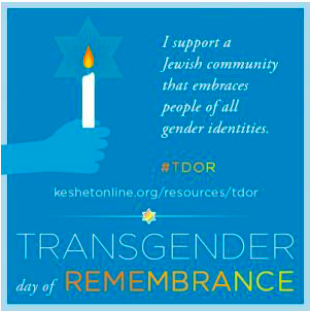
By Rafi Daugherty


When I was growing up, as a little girl in the Orthodox Jewish community, I would stare longingly over the mechitza (the dividing wall between men and women in the synagogue), feeling betrayed by God for giving me a body that didn’t feel congruent with my soul. I never imagined that one day I would feel right in my body, accepted in my community, and able to walk freely in the world as a Jewish man.
This year, Jewish organizations across the U.S. are joining together to keep broadening and deepening that acceptance by observing Transgender Day of Remembrance. Observed annually on November 20th, Transgender Day of Remembrance was established as a day set aside for remembering the lives of those gender non-conforming individuals who were viciously murdered for being themselves. It is sometimes hard for us to make the leap between thinking about people being murdered and what that has to do with our community or with us. We think, “No one I know would ever murder a transgender person!” While that may be true, I challenge us all to ask ourselves: What else can we take away from this day?
Keshet has compiled resources specifically for the Jewish community to observe Transgender Day of Remembrance, such as:
You can visit KeshetOnline.org for liturgy, Divrei Torah, blog posts, and other Jewish resources for observing Transgender Day of Remembrance.
Most transgender people spend years hiding and fearing “coming out” because they do not have a community where they know they will be accepted. Many transgender people, like myself, have used drugs and alcohol to numb the pain of being “different,” and even contemplate suicide to escape from making the heart-wrenching choice between family and being true to themselves. Sometimes I wonder how my life would have been different if I could have known as a child that I could be myself and also be a part of my community. . . .
I hope this day inspires us to ask ourselves:
I ask you to take a moment to think about how you might use November 20th, Transgender Day of Remembrance to find a way to make a difference.
Rafi Daugherty is the Colorado Regional Manager for Keshet, a national grassroots organization that works for the full equality and inclusion of lesbian, gay, bisexual, and transgender (LGBT) Jews in Jewish life.